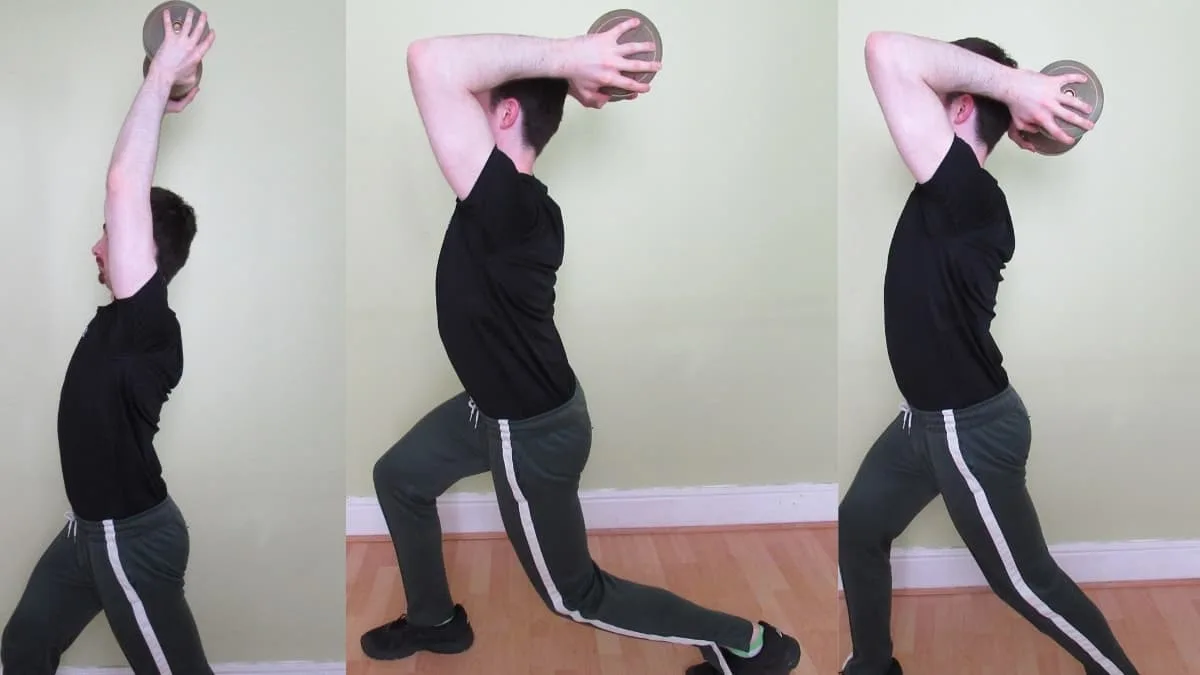We already explained how a lunge bicep curl tones the triceps brachii antagonist while strengthening your legs. But what about the triceps themselves?
When it comes to developing lean, strong arms, the triceps are arguably more critical than the biceps because the triceps account for two-thirds of your upper arm size. Plus, toning your tris via weight training can really help to get rid of the flab on the backs of your arms.
This guide shows you 5 ways to combine a lunge with a dumbbell overhead tricep extension so that you can strengthen your legs and arm simultaneously.
Tricep extension lunge exercise details
- Also Known As: Lunge to tricep extension
- Main Muscles: Triceps
- Exercise Type: Strength
- Exercise Mechanics: Isolation
- Difficulty Level: Intermediate
- Equipment Needed: Dumbbell
How to do a lunge tricep extension
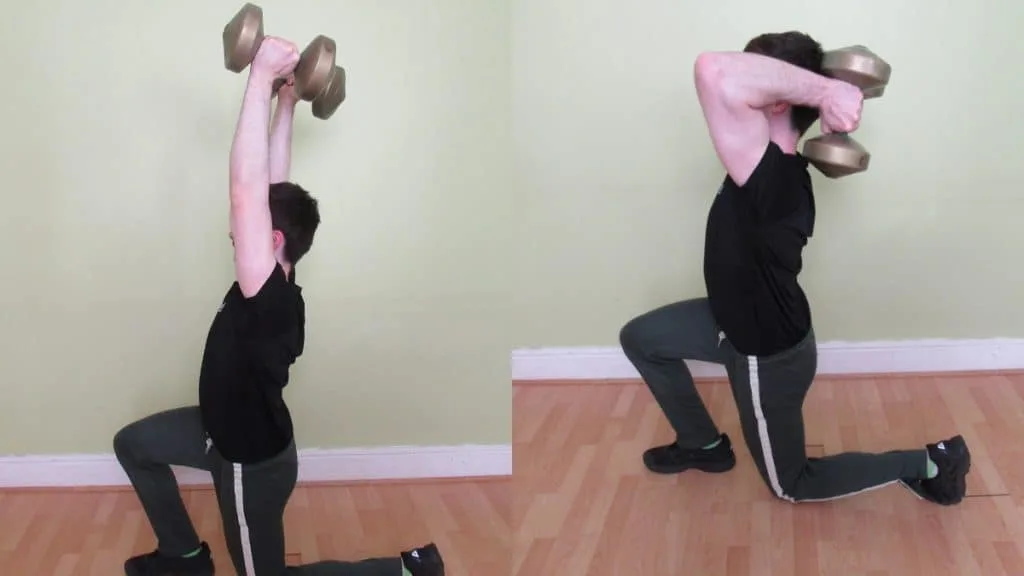
- Grab a relatively light dumbbell by its sides. Alternatively, use two weights for more of a challenge.
- Lunge forward with one leg while keeping the toes of your back leg planted firmly on the floor.
- Keep lunging until the knee of your back leg touches the ground.
- Now perform a tricep extension by lowering the weight behind your head and then flexing your triceps to lift it back up again.
- Push through your front leg to lift your legs and hips away from the ground. Keep going until your torso is straight and your feet are together.
- Repeat the sequence with your other leg and do 3-5 sets of 12-25 reps in total.
Tricep extension lunge variations
You can do a lunge with a tricep extension in many different ways. The best exercise for you heavily depends on your goals and ability level, which is why we’ve explained the benefits and drawbacks of each variation.
Tricep extension to lunge (two weights)
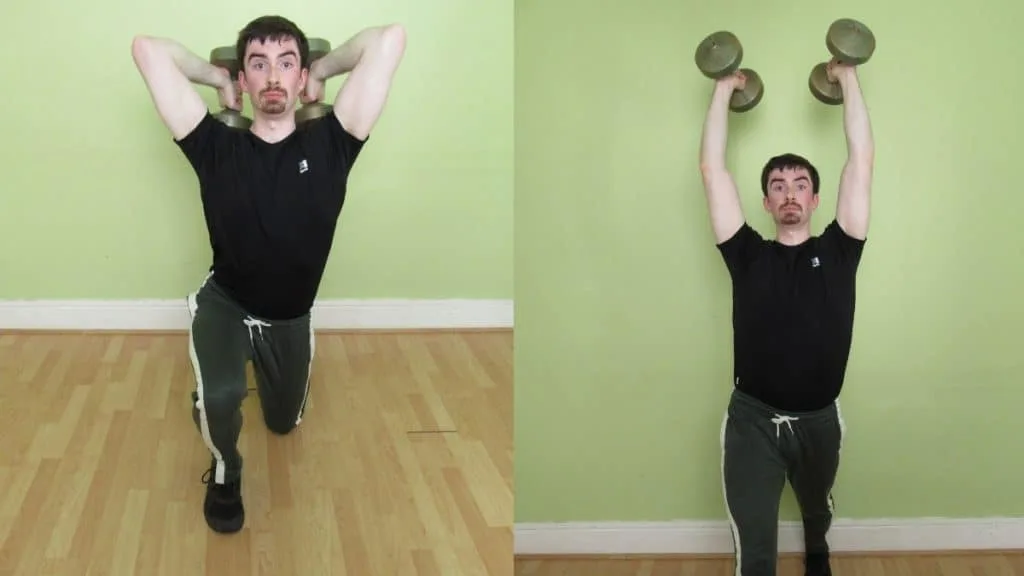
If you want to give both of your triceps equal amounts of work by training each arm independently, then the two-weight triceps extension lunge is a great exercise for the job.
Although it requires more coordination than the single-dumbbell version, the two-weight lunge to overhead extension is the better choice for sculpting symmetrical arms because your stronger triceps muscle can’t dominate the movement.
This is simply because each arm is holding its own weight. So your stronger side couldn’t help your weaker arm even if it wanted to because it’s already preoccupied with lifting its own dumbbell.
One arm tricep extension to lunge
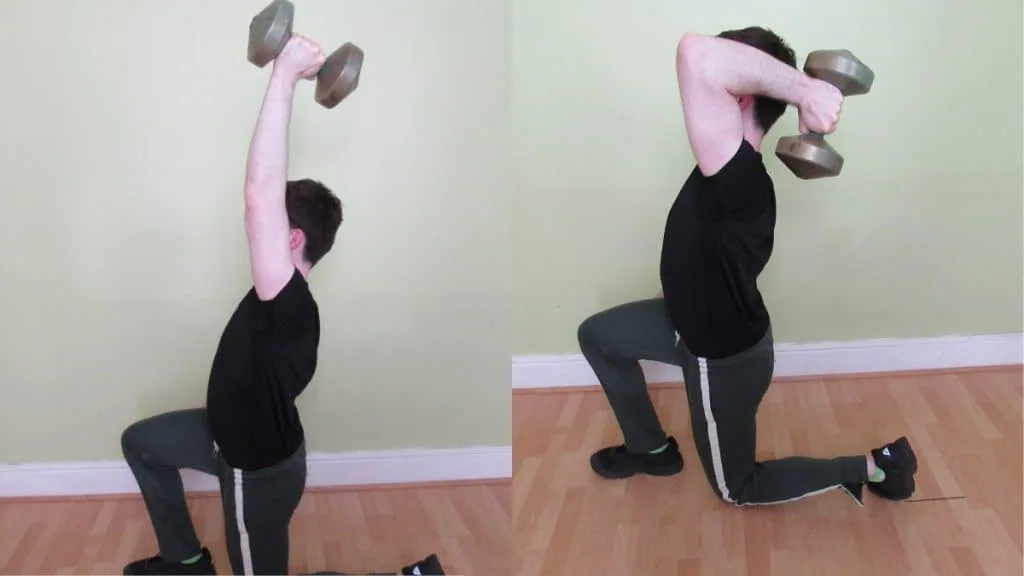
If you want to do everything in your power to develop symmetrical arms and legs, then you can combine the 1 arm tricep extension with a lunge.
To perform this exercise optimally, you lunge forward with your right leg, do a tricep extension with your right arm, and then press through your front leg to push yourself back up. After that, you simply repeat the process with the left side of your body.
The only downside of this triceps extension lunge variation is that you’ll need to move the dumbbell into your opposite hand after every rep. This weight switch makes the exercise slightly more complicated to perform and also means that you won’t be applying quite as much resistance to your legs.
Nevertheless, there’s still less for your brain to think about when you only have to lift one weight. So in terms of difficulty, this exercise is right on par with the two-weight version that you saw above.
Static lunge to tricep extension
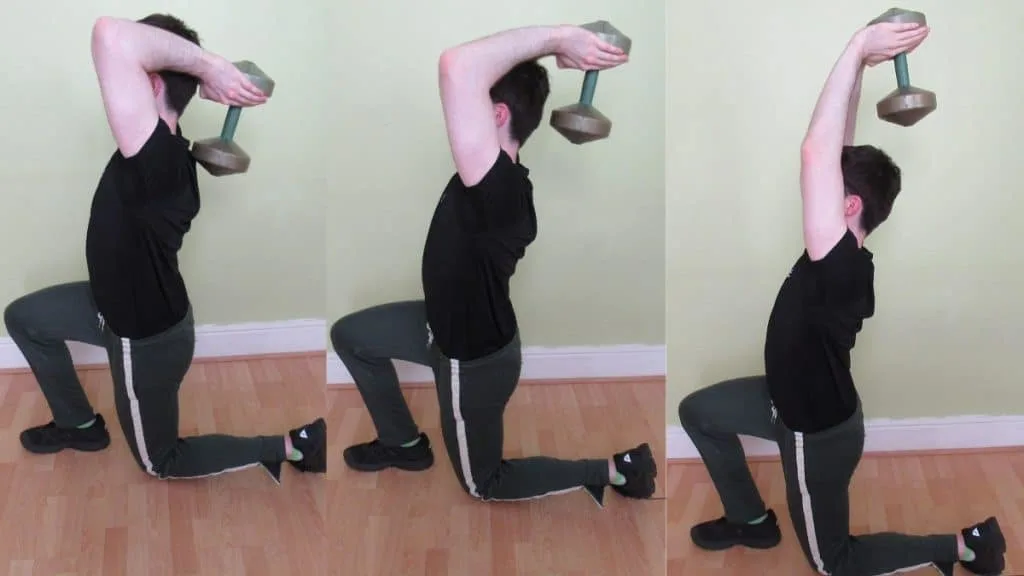
If you want to makes your thighs, tris, and glutes burn, then make sure to include the static lunge to tricep extension in your workout routine.
To perform this challenging upper-body-lower-body exercise, you lunge forward with one leg and then perform a full set of tricep extensions (8-12 reps) while you’re in the lunge position.
This dramatically increases the demand placed on your quadriceps, glutes, and triceps because now they’re not getting a break in between reps; you’re forcing your legs to contract isometrically while you train your triceps dynamically with a full set of overhead extensions.
I recommend doing 2-3 total rounds of the static lunge to triceps extension. One round, in my book, is equal to 4 mini-sets of the exercise, one mini-set being a static lunge followed by multiple tricep extension reps.
Lateral lunge with tricep extension
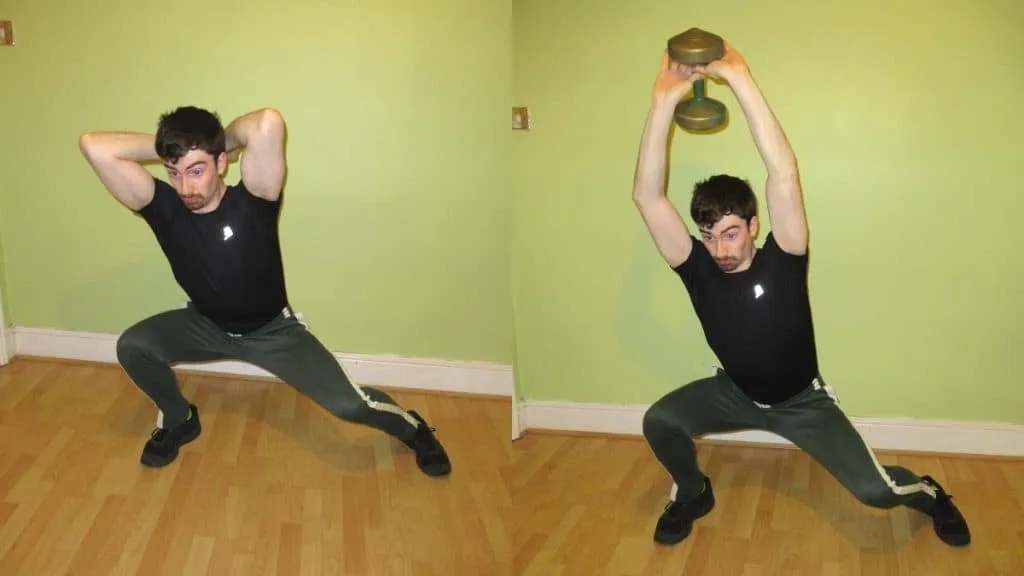
Performing a lateral lunge with a triceps extension really makes your glutes burn because it trains the often neglected gluteus medius muscle via hip abduction.
The side lunge with tricep extension is also customizable to your ability level. To keep things simple, you can perform one full lateral lunge followed by a tricep extension (i.e., you do the extension after you’ve completed the lunge part of the rep).
To make the movement more intense for your glutes, you can perform one or many tricep extensions while you’re in the lateral lunge position. Since a lateral lunge is much more challenging than a regular lunge—especially for your glutes—this variation is best reserved for those who already have strong legs.
Reverse lunge with overhead tricep extension
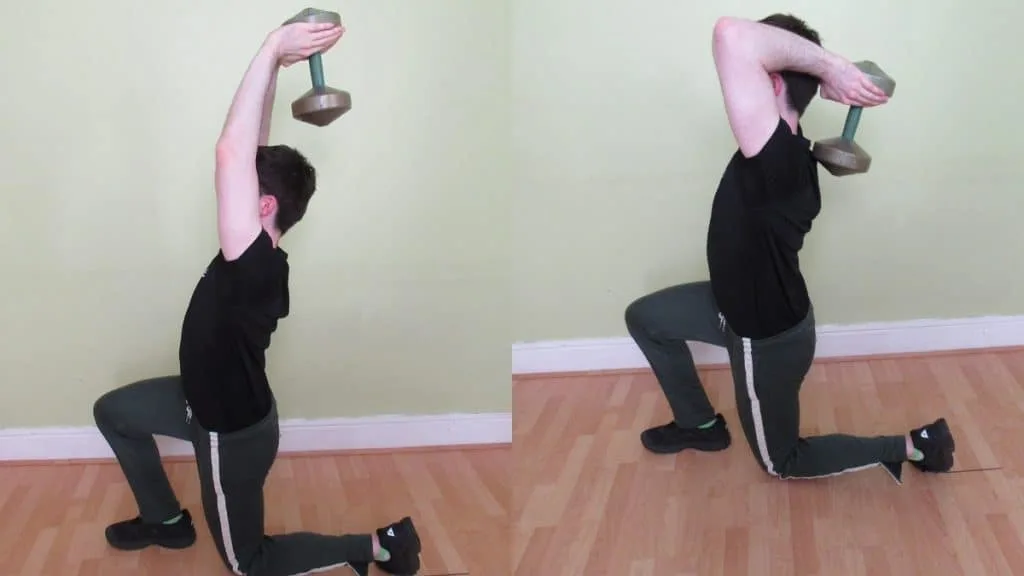
Reverse lunges tend to place more emphasis on the glutes, whereas forward lunges usually place more emphasis on the quads. Thus, performing a reverse lunge with a tricep extension is ideal if you don’t want to put too much pressure on your knees.
Besides changing the direction of your lunge, you can also increase your stride length to work your glutes more. A shorter step, on the other hand, will typically place more tension on the quadriceps because it increases the amount of knee flexion.
To do the exercise, lunge backward with one of your legs while keeping your front foot planted firmly on the floor. Keep lunging until your back knee touches the ground, then perform a tricep extension. Finish the rep by pressing through your front foot to push yourself back up.
What are the benefits of combining tricep extensions and lunges?
Performing a tricep extension with a lunge strengthens your arms and legs simultaneously while getting your heart pumping in the process.
Additionally, the exercise is convenient (certainly a drill that you can do at home) because it requires nothing more than a single dumbbell.
Increased leg strength
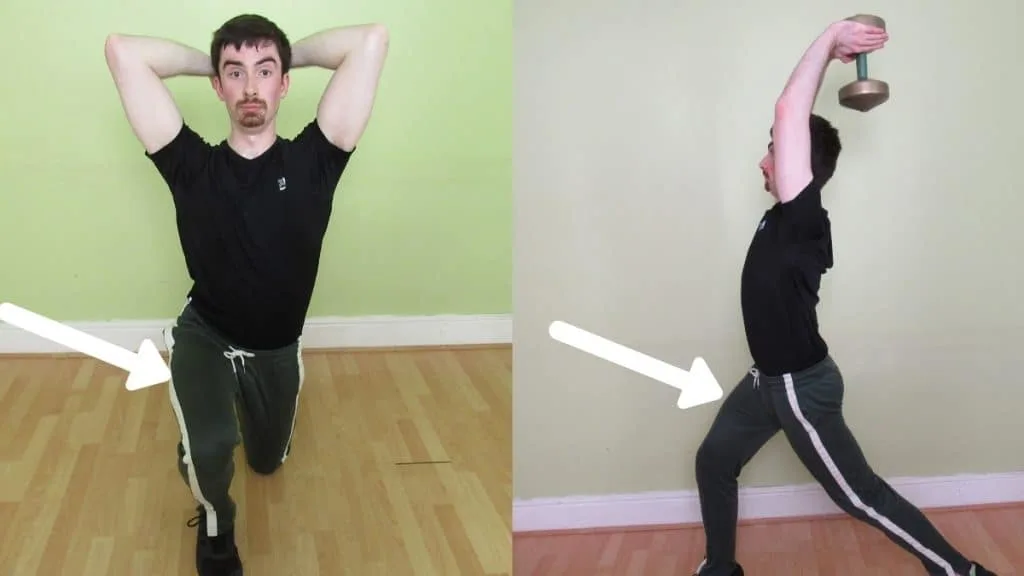
The tricep extension lunge strengthens your glutes and quadriceps more than regular lunges do because you’re holding a dumbbell above your head, which increases the demand that gets placed on your legs.
Yet, because lunges are a unilateral exercise, they naturally provide your legs with similar amounts of stimulation and thus help to prevent or correct any quad and glute asymmetries.
I recommend starting with your weaker leg so that you can train it when you’re at your freshest and strongest.
If you still feel one leg working more than the other, then try and slow down your reps so that your quads and glutes have to work harder to lower your body toward the ground.
Toned upper arms

Many people are unhappy with what they deem to be excess fat on the backs of their arms.
While a good diet is essential for losing body fat, you still need to apply some stimulus to your arms in order to make them lean and muscular.
The lunge tricep extension is a great exercise in this regard because it provides enough resistance to sculpt lean, slender muscles, but not so much that you’re going to build tons of mass.
As mentioned, you can also use separate weights for each arm so that your triceps get equal amounts of work, which in turn helps them to develop in proportion.
The trick is to lower the weights deep enough (behind your head) to where you feel an intense stretch in the backs of your arms. After that, you want to flex your triceps to lift the dumbbells back up. When your elbows reach full extension, that’s the end of the rep.
Improved balance
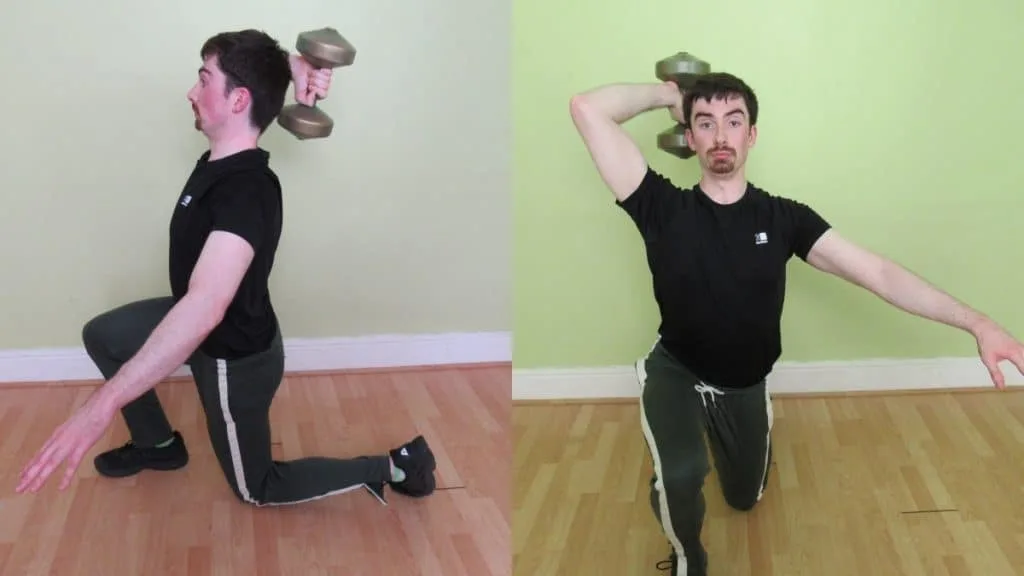
Unilateral exercises like the side lunge with triceps extension or the more simple forward lunge tricep extension require more balance than their bilateral counterparts.
Improving your balance via the tricep extension lunge will increase your core strength and your proficiency at similar arm and leg exercises. After all, if you’re strong enough to do a one-leg lunge while holding a weight above your head, then two-legged squats will feel easy.
Conclusion
The overhead extension lunge works two of the biggest muscles in your legs—quadriceps and glutes—while challenging the largest muscle in your upper arms. For this reason, the triceps extension lunge is a highly efficient exercise because you’re training three muscles in the same amount of time that it would usually take to work one.
Because of its full-body nature, the lunge to tricep extension also provides a good cardiovascular workout when you perform high repetitions, a benefit that will improve your ability to handle high rep, high volume training in general.

